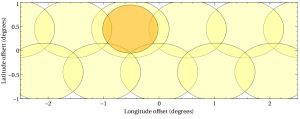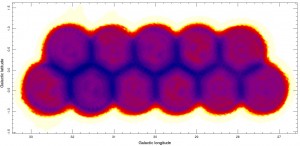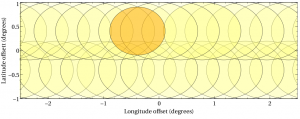The two observing modes – Daisy and Pong’s lend themselves naturally to a hexagonal tiling pattern for mapping large areas. Classically Daisy observations are used for more targeted observations – obtaining lower noise levels in shorter integration times. Pongs’ cover larger areas with a smoother noise gradient.
Static hexagonal scheme
The static hexagonal scheme is currently in use by surveys such as the JCMT Plane Survey team and the SCUBA-2 Ambitious Sky Survey. This method the tiles overlap slightly at the edges. The advantages of this method is the ability to control the final rms per tile (via number of repeats, tau/elevation constraints) when multiple pongs are required to get to target depth. The disadvantage of this method is additional overlapping coverage produces highly varying coverage maps in terms of the final map rms.

An example of the Static Hexagonal Tiling Pattern. Orange – requested 1 degree pong. Yellow – useful coverage area extends beyond the requested pong size.

Example of the Static Tiling Scheme is practice as used to map one of the JCMT Plane Survey regions.
Overlapping hexagonal scheme
The overlapping hexagonal scheme has been used to map the center of the Galactic Plane. The advantage of this method is that the scheme takes advantage of overlapping pongs to produce an fairly smooth rms coverage. The disadvantage is controlling the consistency of the overall rms.

An example of the Overlapping Hexagonal Tiling Pattern. Orange – requested 1 degree pong. Yellow – useful coverage area extends beyond the requested pong size.




